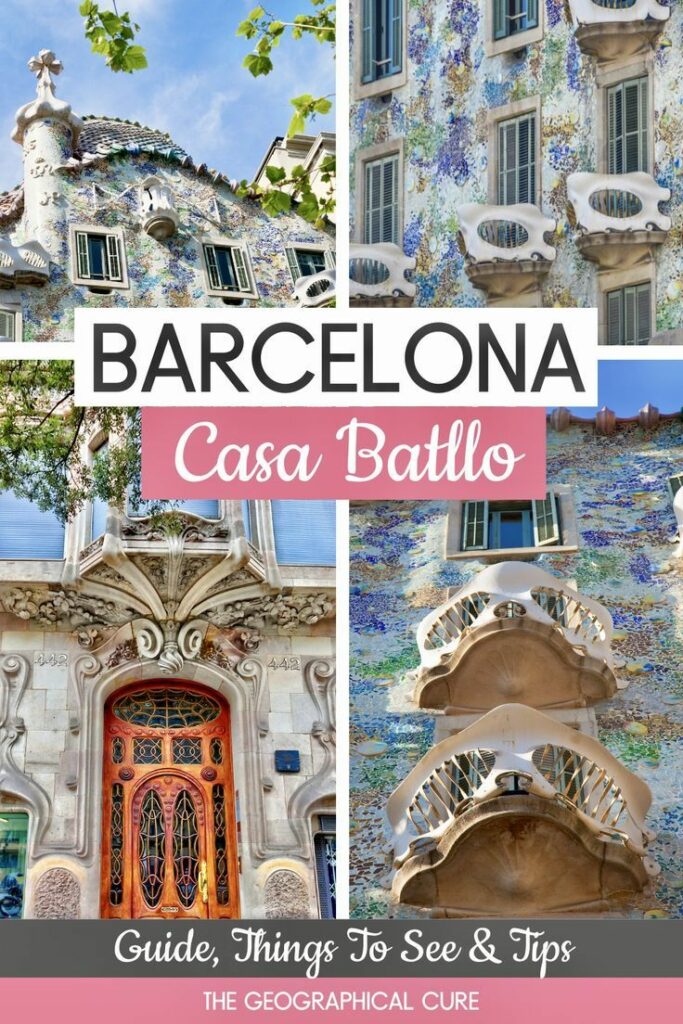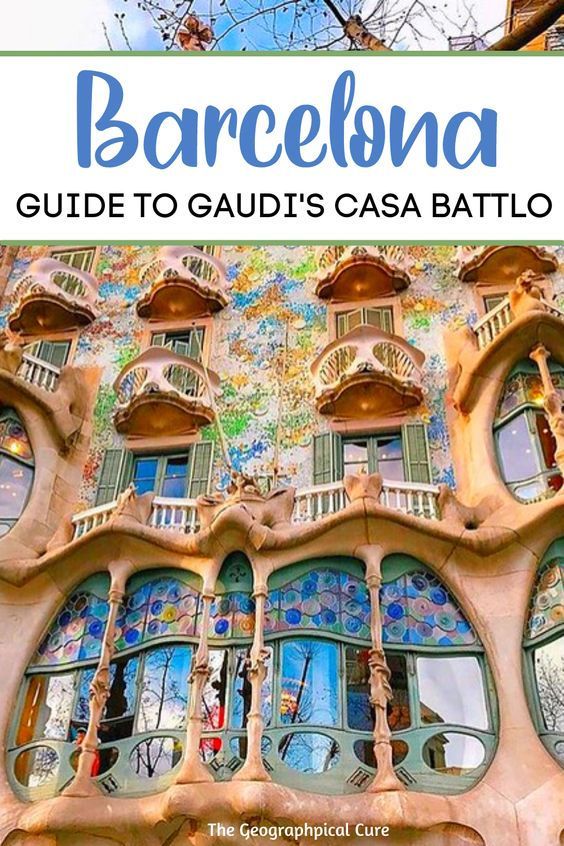Casa Batlló is a Modernist gem in Barcelona. It’s Antoni Gaudí at his hallucinatory, dreamlike best.
For Casa Batlló, Gaudí conjured a building in the image of a dragon. The strange bone-like facade commands your attention. It’s studded with skull mask balconies and capped by a sinuously scaled roof with a solitary sword-like tower.
Casa Batlló is divine and operatic. And dragon-like. But in a rather pretty way without fearsome overtones.
In this Casa Battló guide, I give you an overview of the building, tell you everything to see, and give you tips for visiting.
Quick Tips
- pre-book a timed entry skip the line ticket
- arrive 15-20 minutes early to line up
- get in the right line for your designated time
- if you get the iPad, you can see what the original furniture looked like
- there’s a set visitor route and a garden cafe on the roof
Mini History & Overview of Casa Batlló
Casa Batlló is located on the prestigious Passeig de Gràcia in Barcelona’s Manzana de la Discordia. This tony area is also known as the “Block of Discord.”
The city block’s nickname originates not from a dragon legend, but from a famous Greek legend about discord. It goes like this.
All the Greek gods were invited to my big fat Greek wedding. Except for Eris, the unpopular goddess of discord, who sowed misery wherever she went.
Aggrieved and irritated by the snub, Eris gate-crashed the party anyway. She arrived bearing a poisoned “gift” of a golden apple.
It was inscribed with the word “kallisti,” which means “for the fairest.” She flung it into the wedding crowd and started a chaotic battle.
As Eris anticipated, the goddesses viciously fought to claim the apple and its coveted title.
To end the incessant squabbling, Zeus ordered Paris, the Prince of Troy, to select the fairest goddess among the three remaining candidates. Paris offered the apple to Aphrodite and she was crowned fairest.
The word “manzana” can mean both city block and apple in Spanish. And on the Manzana block, there was a similarly fierce rivalry, akin to the golden apple, albeit in architectural terms.
There were three pretty Modernist buildings on the tony Passeig de Gràcia, all vying for the title of the fairest.
The competition was fierce. Built between 1898-1906, each one tried to better the last one built. They all had disparate Modernist styles.
Right next door to Casa Batlló is Casa Amatller, with colorful Neo-Gothic elements. It was built in 1900 for a chocolate baron and the building gives out chocolate samples on tours. In case you have a sweet tooth.
At the end of the block is Casa Lléo Morera, from 1905. It’s covered with floral flourishes and an ornate cupola. A fourth house, Casa Mulleras, is sometimes included in the beauty competition.
Casa Batlló likely wins the prized apple. It’s uniquely stunning and a UNESCO site to boot. And, after all, no other house is a dragon.
Now back to that ancient Catalon dragon legend. Barcelona loves dragons. Dragon statues are a relatively common sight.
Casa Batlló is nicknamed Casa dels Ossos (House of Bones) or Casa del Drac (House of the Dragon).
The design of the house itself was inspired by the Catalan legend of Sant Jordi (St. George) and the Dragon.
According to legend, a ferocious dragon — capable of poisoning the air and killing with his venomous breath — terrorized the Barcelona citizens. Traumatized by the dragon’s misdeeds, they chose a deadly alternative.
To calm the dragon and prevent wanton destruction, they fed the fire breather one person per day. Random selection.
After several days, the princess was the unlucky designee. As she trudged gloomily towards the dragon and certain death, a chivalrous knight named St. George appeared on the horizon and interceded.
Dressed in shining armor and riding a white horse, he swooped in to rescue the beautiful damsel in distress.
He raised his sword and stabbed the dragon, freeing the princess and citizens from its grip. Beautiful red roses spilled out of the dragon’s body. The prince gave one to the princess.
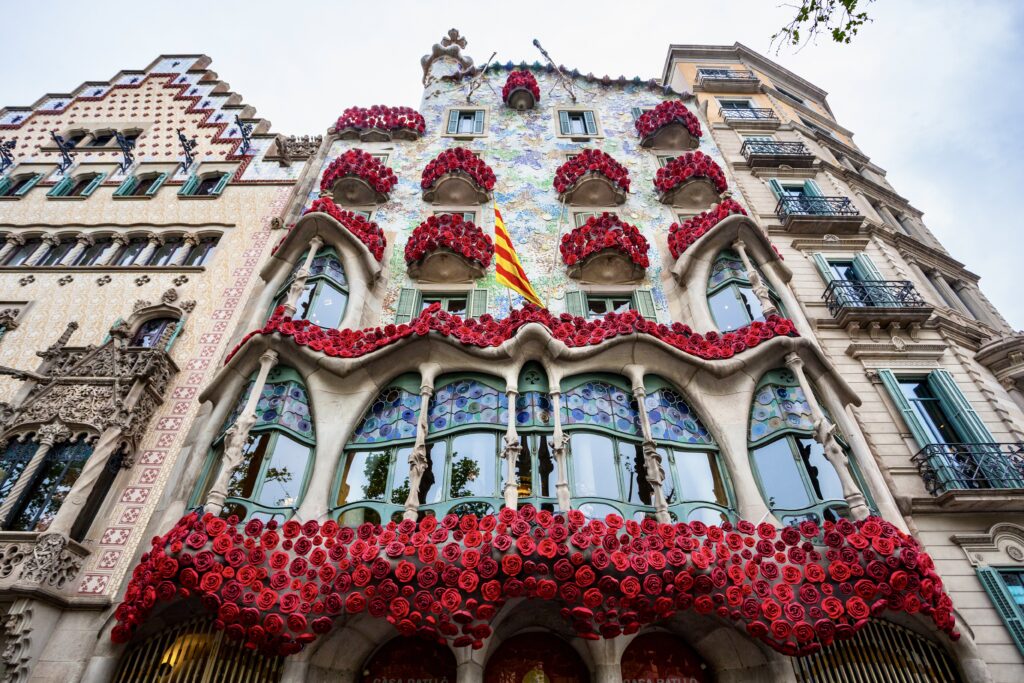
Barcelona celebrates this legend with an annual festival on April 23. The festival combines culture and romanticism.
Gifts and roses are exchanged between beloveds. Casa Batlló is even decorated with roses for the big day.
The building that was transformed into Casa Batlló dates from 1877. In 1900, Josep Batlló y Casanovas, a wealthy textile industrialist, purchased the building.
In 1903, he hired Gaudì and gave him full creative freedom. That’s basically the only way you can hire Gaudì. He has his own ideas.
Gaudì decided not to demolish the building. Instead, he gave it a major makeover — a new facade, a new roof, and a gorgeous new interior.
As a result, unlike Casa Mila (aka La Pedrera), Casa Batlló was not entirely a Gaudì creation from top to bottom. It was a remodeled pre-existing building that he “put his hands” on and reinvented.
Casa Batlló adopts the Art Noveau style in vogue in Barcelona and the world at that time. But it’s an extreme curvilinear version.
Nonetheless, it was an instant hit, unlike La Pedrera. With 8 other buildings in Barcelona, it was named a UNESCO World Heritage Site in 1984.
Casa Batlló is privately managed and funded by Casa Batlló S.L.U. In 2002, it was opened to the public. You can see the Noble Floor, the building well and explore the rooftop terrace.
Guide To Casa Batlló: What To See
Casa Batlló might be Gaudì’s most iconic facade. It’s one of the most creative facades in the world.
Most people come for a look, gasp, and stagger on to the next Gaudì wonder.
But the interior’s worth a visit too. And, as promised, the building’s an emblem of dragon iconography.
Exterior Facade
At Casa Batlló, the entire facade is a kaleidoscope of blue, mauve, and green tiles. A marine-like surface. Though it’s a bit hard to see, the facade’s actually uneven and slightly wavy, like a calm sea.
You might even think it resembles Monet’s famous water lilies at the Orangerie in Paris. Though those paintings post date Casa Batlló.
To decorate the facade, Gaudì used a technique called Trencadís.
It’s a method used to cover structures with abstract mosaics, using irregular and broken pieces of ceramic, glass, marble, or even stone.
Gaudí liked this technique due to its sustainability and aesthetic value. An intuitive recycler, he was ahead of his time.
Legend holds that the technique was born when Gaudí visited the ceramics workshop of Lluís Bru.
When he saw how slowly Bru was putting tiles in place, Gaudí got impatient, grabbed a tile, broke it. He said: “We have to put them on by the handful, like this, or we’ll never finish!”
The Trencadís technique gave Gaudì flexibility in designing his facade patterns. It could be fitted to rounded shapes. He chose vivid clear colors to bring light, dynamism, and energy to his work.
The facade is adorned with macabre balconies. They loom over the facade like leftover skulls from the dragon’s meals.
The skull balconies also resemble Venetian masks. This emphasizes the over-the-top operatic nature of the place.
At the very top of the facade, you’ll see a small center balcony in the shape of a rose, an ode to St. George. Gaudì was all about the details.
Interior
Gaudì also completely revamped and beautified Casa Batlló’s interior.
It’s filled with beautiful tiles, curved wood, rippling ceilings, and stained glass — all in organic forms and curvy shapes.
The motif is an undersea grotto lit by skylights shaped like tortoise shells. The ceiling droops and swerves poetically.
1. Noble Floor
The long gallery of the main suite is called the Noble Floor, the most beautiful space inside. It overlooks the Passeig de Gràcia via a magnificent window.
The oversized window is the floor’s most astonishing feature. It’s decorated with bone-like pillars and watery colors. The curved wood windows are so large that they have spawned a third nickname for the building — the House of Yawns.
I guess they could also be considered the entrance to the dragon cave or the mouth of the dragon.
The Noble Floor was the Batlló family’s residence. It is 7,535 square feet — quite a sizable “apartment” space. It’s soft and curvy.
You may feel like you’re strolling through the internal organs of the resident dragon or gliding through gentle ocean waves.
From the entrance hall on the ground floor, a sturdy iron railing separates the private access to the Batlló family residence.
A grand wooden staircase leads up from the skylight hall. The bannister is a a dragon-like spine.
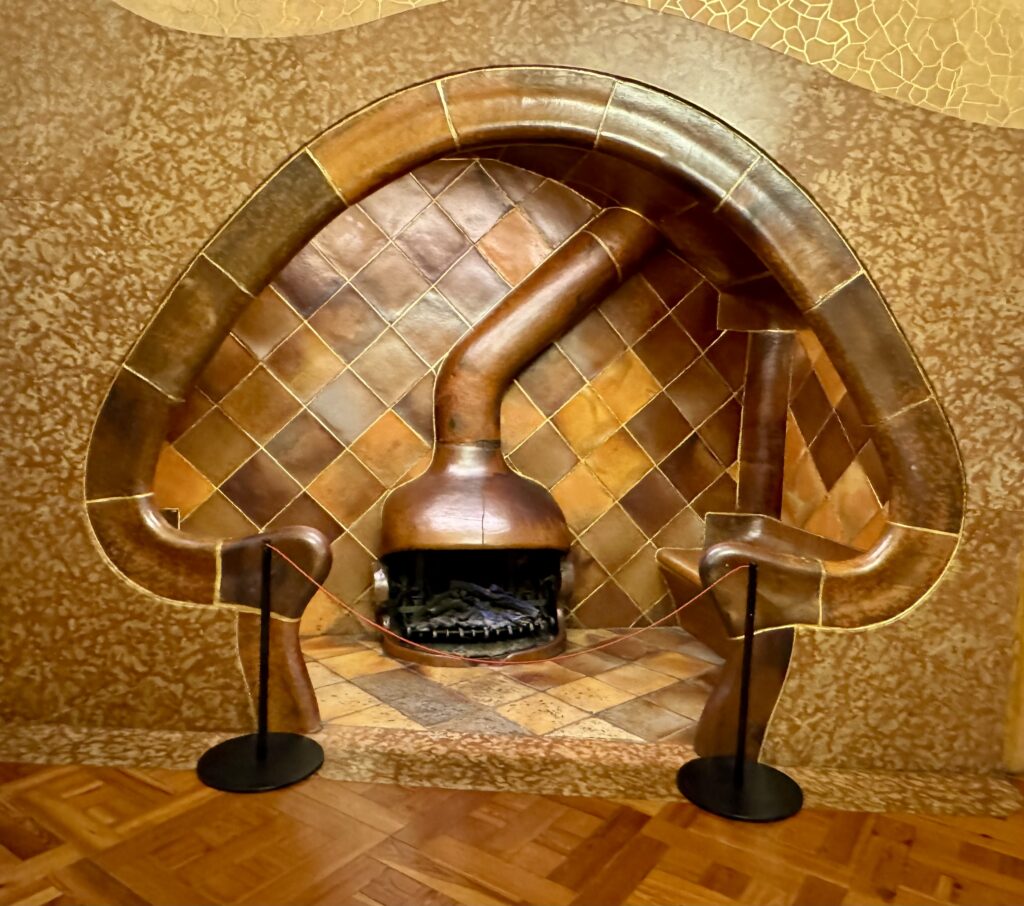
2. The Whale Bone Attic
The attic sports 60 catenary arches, in a pristine white space. It conjures the feeling of being inside the ribcage of a great animal.
Perhaps a whale. Or perhaps the dragon that sits above it on the roof.
It was formerly a service area for the tenants of the different apartments in the building, which contained laundry rooms and storage areas.
There’s now an air shaft providing light to the apartments, an earlier version of what Gaudí did more effusively at La Pedrera.
Gaudí enlarged the existing light well and covered the walls in bas relief glazed tiles in varying shades of blue.
The tiles are darker in color at the top and lighter towards the bottom, thus providing an even distribution of light.
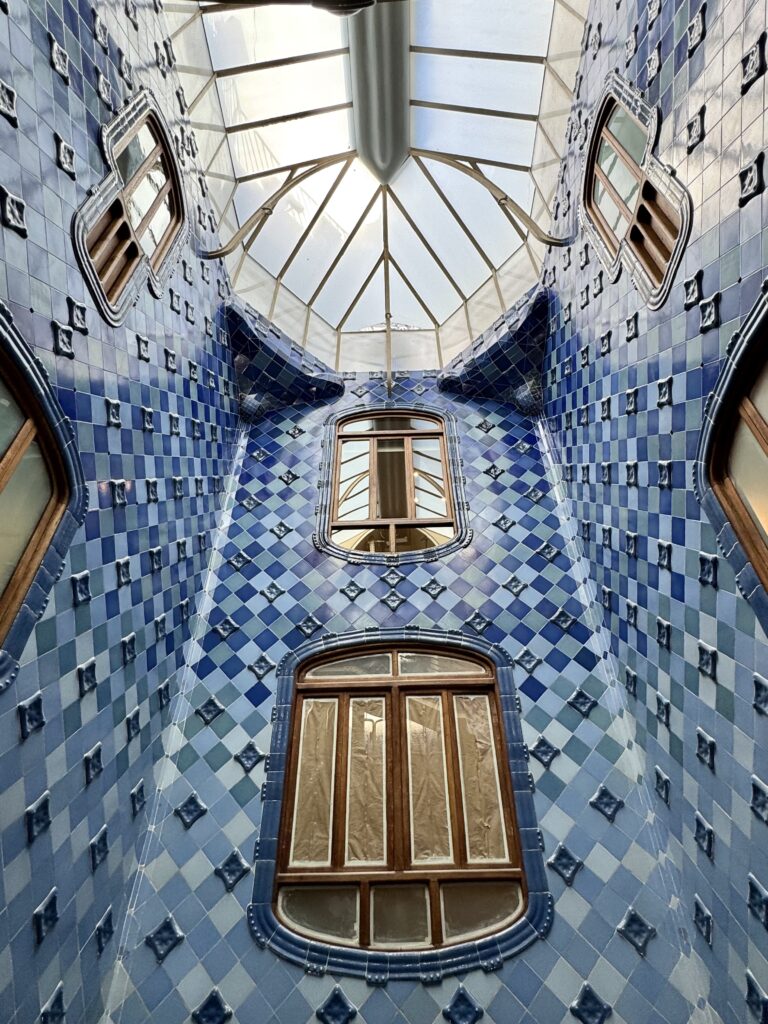
3. The Atrium
The atrium is called the “patio of lights.” Located at the heart of the building, this space serves a dual purpose.
It functions as a lightwell, channeling natural daylight deep into the interior spaces of the house. This ingenious design not only minimizes the need for artificial lighting during the day but also bathes the interiors in a warm, ethereal glow.
Gaudí’s signature organic and fluid architectural forms are prominently displayed in the sinuous curves and unique blue decorative elements that adorn the atrium.
Moreover, the atrium’s stained glass windows and skylights add a mesmerizing kaleidoscope effect as sunlight filters through.
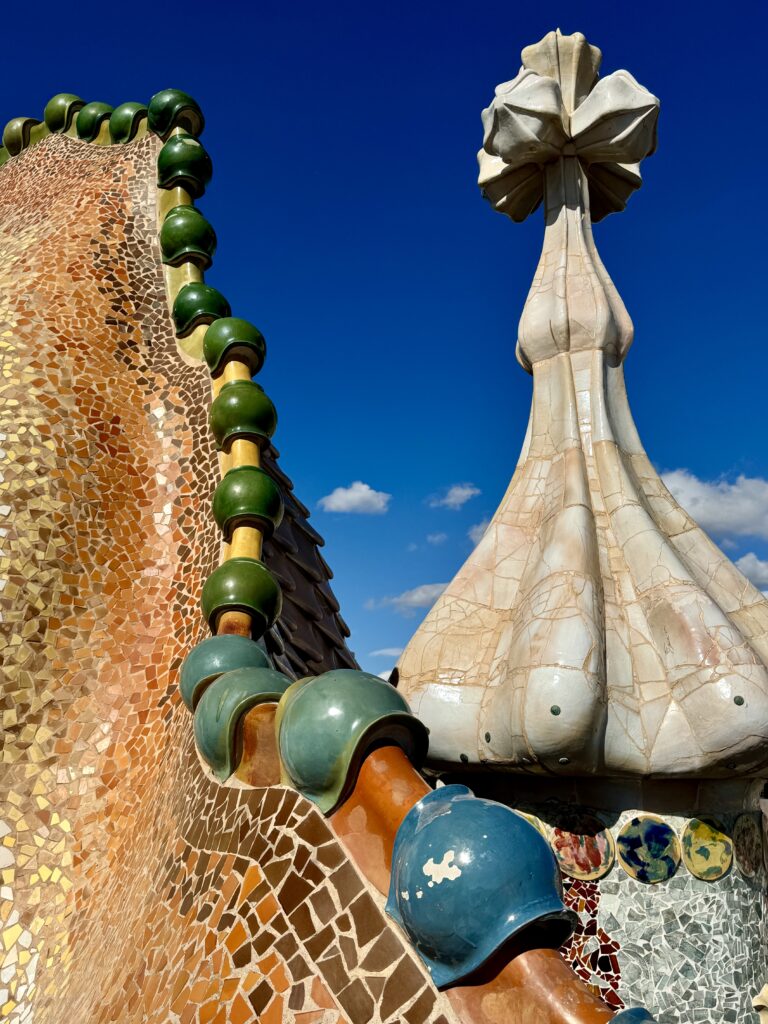
The Rooftop
The extraordinary rooftop adds to the surrealistic feel of Casa Batlló.
You can see it’s deliberately scaly. It looks like the back of a dragon or dinosaur with iridescent skin and visible raised spines.
The riotously colored Trencadís tiles represent the blood of its victims. The rooftop spire represents the sword of St. George being plunged into the dragon.
Currently, Gaudi’s “hidden garden” is being restored, so plants join the colorful display.
There’s also a cafe at the top if you want to linger longer. You can also get your picture taken on the balcony, if you want a souvenir of your visit.
Magic Cube
The last room that you’ll visit is called the Magic Cube.
Inaugurated in 2021, it’s an immersive experience that aims to get you inside the mind of Gaudi. It’s a dream-like sound and light show created by artist Refik Anadol.
You wait your turn and then are shuttled into a room, which is a 6-sided LED cube. Every inch of space is filled with light.
Most people were sitting down to experience it.
Practical Guide & Tips for Visting Casa Batlló
Despite its rather sticker shock price tag, Casa Batlló is definitely worth visiting while you’re in Barcelona. You should at least stroll by and inspect the facade.
I highly recommend pre-booking a timed entry ticket well in advance of your visit. This is a hugely popular attraction and will likely sell out, especially from spring to fall.
If you have a Barcelona City Pass, that will also give you fast track access to Casa Batlló.
The best time to visit Casa Batlló early in the morning, at siesta time, or an hour before it closes at night.
If you want to closely inspect the dragon spine and the Trencadís tiles in the event, you can buy tickets for Magic Nights.
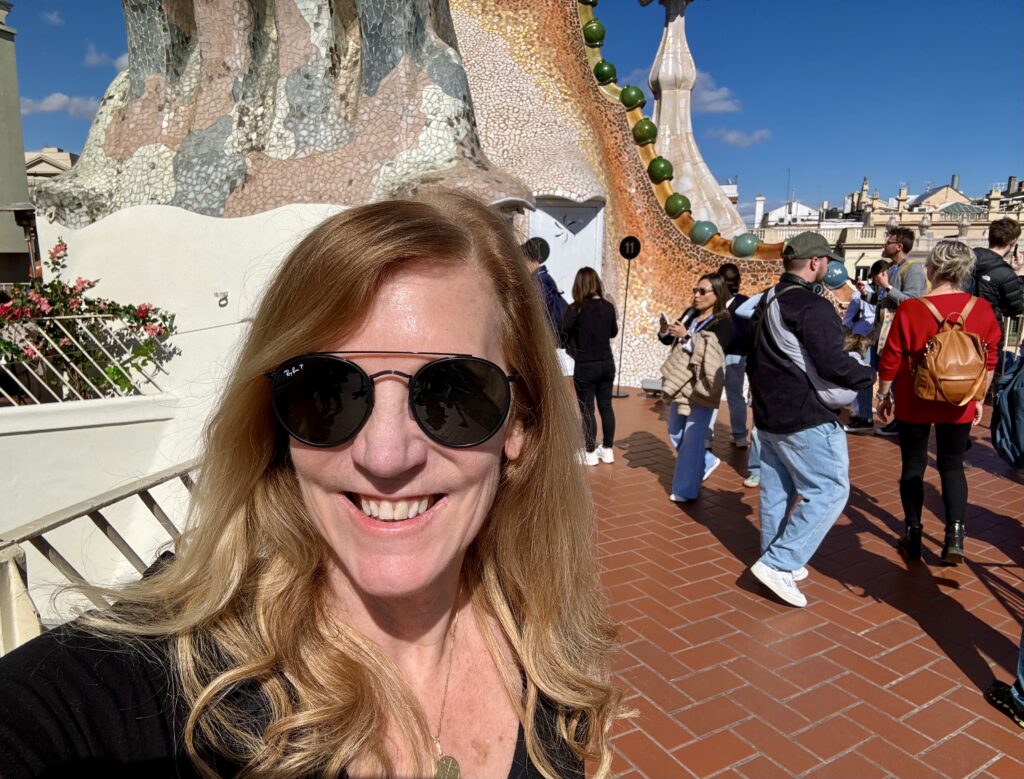
Address: Passeig de Gràcia, 43
Hours: 9:00 am to 10:00 pm, daily, last entrance at 9:00 pm.
Tickets: Ticket + audio guide is 35 euros. Click here to pre-book a skip the line ticket. The iPad audio guide will let you see what the building once looked like furnished.
I don’t think you really need to book a tour. But, if you want to, I recommend booking a joint tour of Casa Batllo and La Pedrera. Guides will be able to give you the historical backdrop and give you photo tips.
How Long To Visit?
I spent 1.5 hours exploring the building. If you get the iPad audio guide and listen to the entire thing, it will take you 3 hours.
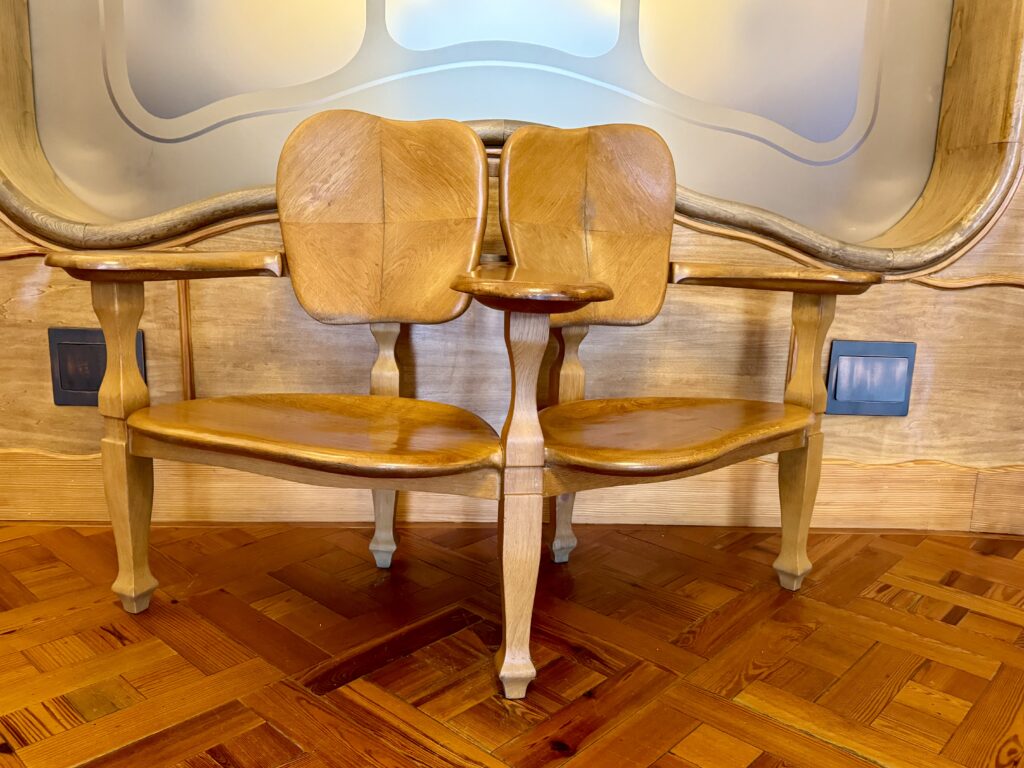
Pro Tip:
There are two gifts shops. You’ll go through one before you go up to the roof.
I also highly recommend a visit to Casa Amatller, right next door. The interior is amazing, with original furnishings a Moorish style Modernism.
I hope you’ve enjoyed my guide to Casa Batllo. You may enjoy these other Barcelona travel guides and resources:
- 1 day itinerary for Barcelona
- 3 day itinerary for Barcelona
- 40+ Landmarks in Barcelona
- Guide to Sagrada Familia
- Guide to Gaudi Architecture
- Hidden Gems in Barcelona
- Architecture Lover’s Guide to Eixample
- Guide to the Gothic Quarter
If you’d like to visit Casa Batllo in Barcelona, pin it for later.

